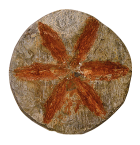Archaeological excavations of the west wing - 2018
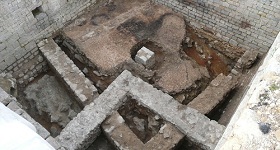 | Since the 18th century, the west wing of the monastery had been completely collapsed and filled in. Before restoration work was begun, archaeological excavations were carried out between January and August 2018. So, the excavations were carried out area by area and often manually because of the smallness of the rooms. |
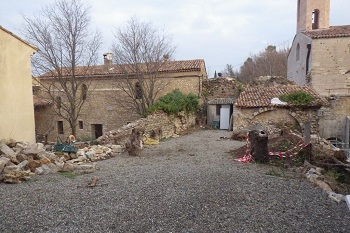 | From a technical point of view, these excavations were fairly complex as it was impossible to bring large vehicles into the building. All the rubble had to be taken out in big bags using a crane positioned outside the buildings. The west wing before the works |
 | So, the excavations were carried out area by area and often manually because of the smallness of the rooms. Removal of earth in big bags |
 | The plan opposite makes it easier to identify the excavated areas. They consist of the cloister walkways and three adjoining rooms which were named A, B and C. |
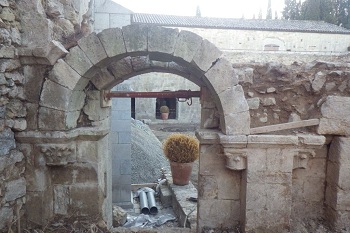 | The first area to be cleared in February 2018 was the part north of the cloisters. In the upper part, the earthworks uncovered the connection with the north walkway, revealing a bay framed by columns with sculpted bases and capitals. The capitals |
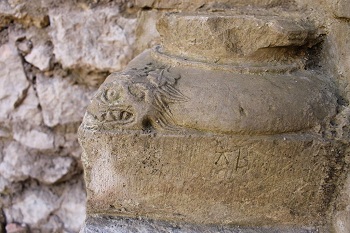 | One of the sculptures, which is particularly remarkable, is the one which represents a small “diabolical” animal. The diabolical animal |
 | In total, the walkway opens onto the courtyard via five bays, three of which were not previously visible as cladding had been applied on this side in the modern era. The courtyard before the works - Credit Marc_Heller |
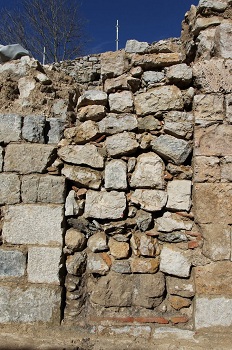 | On the western side, the earthworks uncovered the walled door to room A, now the access door to the monument's reception area. This confinement had been carried out in several stages. The passageway was first blocked off to serve as a cupboard (you can see the notches for the shelves) then this was closed off with an arrangement of stones. Entrance to room A |
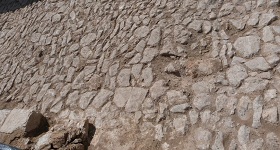 | The modern floor, dating from the 17th century, consists of cobblestones. It is crossed by the pipe from the overflow of the primitive wash basin (CN1 on the plan) already revealed in the excavations carried out in the courtyard in 2015. A piece of lead piping wedged under the dividing wall with room A, proves that the monolithic blocks acted as a covering for a lead pipe. The cobblestone floor |
But to go further back in time, you have to dig deeper. So, after making a meticulous record, the cobblestones were removed in order to excavate the mediaeval floor.
Underneath the backfill, a wall (MR1) bound with pinkish lime mortar and an abutment (or pillar base) attached to it to the north were exposed. These must belong to the period immediately preceding the monastery, around the 10th- 11th centuries.
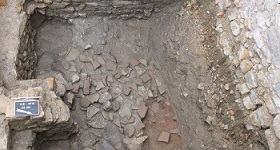 | To the north of the wall, the excavations reached, under earth levels dating back to Late Antiquity/High Middle Ages (5th-7th centuries) a backfill containing numerous fragments of tegulae (tiles) and dolia (ancient vases) which covered a well-preserved floor of lime mortar and stones belonging to the ancient villa. Tegulae |
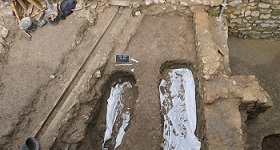 | On either side of the MR1 wall, seven graves were found with different burial methods: - a grave SP1 with a stone built casing, and a head recess which penetrates wall MR1; - two graves covered with stone slabs SP2 and SP3. The grey ceramics found in the material filling these graves and in the upper backfill can be dated back to the 10th-11th centuries. These two tombs are fairly similar to those found in the courtyard during the 2015 excavations and are probably from the monastic era like SP1; - a grave SP7 dug in the natural soil of which only the head was accessible (does not appear on the plan). This is probably the oldest grave as it penetrates the concrete floor of the Roman villa; - two children's graves SP6 and SP4. In the latter, the legs have been caught in the foundations of the eastern wall of the walkway; - a grave with a mixed casing (stone and tiles) SP5.Graves SP2 and SP3 |
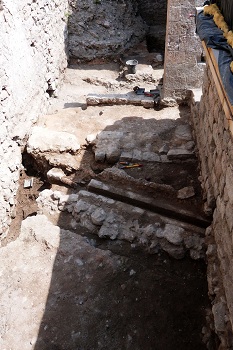 | Once the excavations were completed, this part of the walkway was filled in, in order to access room A. The clearing of room A had begun at the beginning of March 2018 to reach the modern 17th century floor which included a pipe running east-west, crossing the room and containing ceramics from the same era. When excavations were resumed, levels dating back to the 13th century were reached. These revealed the end of the pipe from the overflow of the wash basin in the primitive monastery which stopped abruptly in this room. As the western boundary wall was probably not later than the pipework, the archaeologists hypothesised that there was a water supply for this room by via a receptacle, of which only the collection pit remains. A wall which can be dated back to the 10th-11th centuries crosses the room east-west as an extension of the one discovered in the adjoining walkway (MR1). North of this wall, the excavations reached a grave with a stone slab casing. The skeleton, of a young person, is covered at the head by the foundations of the west boundary wall, which suggests that it is older than the monastery.Room A |
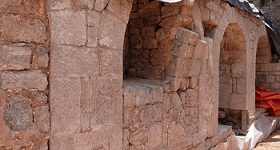 | The following room “B”, which we now call the “Storeroom” features the oldest walls in the west wing of the abbey uncovered during the excavations. On the walkway side, the wall of the room consists of two thicknesses of dressed stone. The external part consists of a thin cladding that can be dated back to the 13th century. On the inside, the clearing of the room revealed a 12th century wall with four openings. The arcade wall
|
 | The south wall of the room connected to one of the arcades of the first monastery also dated from the 12th century. The wall with small windows |
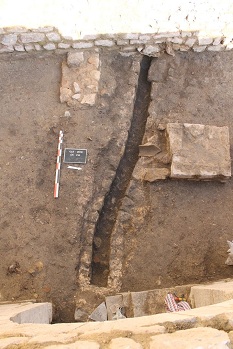 | Underneath a stony floor and a modern partition, the foundations of a pillar and a wall running east/west were unearthed. The pillar, the wall and the water channel |
As the excavation continued, a constructed water channel appeared. This was built into the foundations of the primitive monastery and allowed rainwater from the courtyard to be drained.
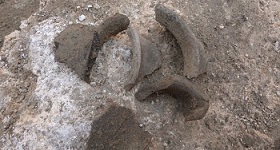 | The complete excavation of the room was limited at its northern extremity, where a scrap of wall probably from the late Antiquity villa (5th-6th centuries) appeared, as well as a backfill of large fragments of tiles and vases which covered a concrete floor from the early Roman Empire villa (2nd century). The grey ceramics |
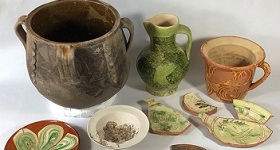 | The next room is room “C”, today named the “Old parlour”. After the monastery was abandoned, it was used as a rubbish dump and numerous ceramics from the 17th and 18th centuries were found there. It is accessed by a vaulted passageway which dates from the second monastery and which was blocked off in the modern era.The restored ceramics |
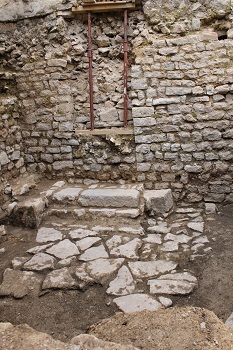 | The first stage of the clearance revealed irregular paving the top layer of which contained objects that could be dated to the 15th and 16th centuries, and the steps of a staircase linked to an opening in the west wall which connected the monks’ priory to that of the nuns. The staircase and the door |
 | In continuing the excavations, we reached occupation levels prior to the monastery (10th-11th centuries). They revealed that the south wall of the monastery reused a wall from the ancient villa as a foundation. Two other walls were unearthed including one partly destroyed by a gutter. Excavations of room C |
When the excavation of the rooms was completed, that of the walkways was able to resume, first in the southern section and then in the central section.
 | In the south wall of the walkway, a cupboard forming a recess in the wall had previously been uncovered. The door rebate and the grooves for the shelves are still clearly visible. The cupboard |
As in the northern part, the modern cobblestone floor, which was removed in order to excavate older layers, covered the entire surface area of the walkway . In the south-west corner, the extension of the north wall of the south walkway of the primitive monastery, which had been unearthed during the 2011 excavations, was found. This wall, of which a course of masonry survives, ends on the west side at the pier (lateral part) of an opening, the other pier of which is built into a wall adjoining the corner of the storeroom. Still in the corner with the south walkway, a wall running north-south has been built into the construction of monastery 2.
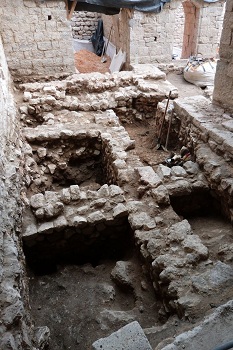 | The excavation under the floor of the primitive monastery unearthed a sooty dirt floor belonging to the 10th and 11th century residence and containing numerous ceramics and animal bones. This floor covered several walls from the High Middle Ages made from undressed rubble stone bound with lime. These walls were partially used until the 10th-11th centuries before being filled in. Walls of the walkway, south-west corner |
In the central part of the walkway, a further section of the water channel found in the storeroom was found. It was built into the corner of the south and west walkways.
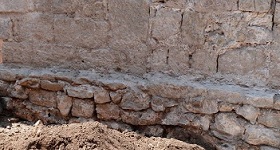 | On the courtyard side, the wall of the walkway of the primitive monastery, 62 cm wide, had been reused for the construction of the wall of the second monastery, up to the “diabolical animal” bay at the north end. The foundation walls |
On the west side, the dismantling of the first steps of the staircase between rooms A and B uncovered the lining of the wall of the primitive monastery with the foundations of monastery 2. Further north of the staircase (by room A), the wall of the primitive monastery disappears and only the foundations of the wall of monastery 2 can be seen.
 | At floor level, underneath the backfill from the 10th-11th centuries, a wall made from undressed stone bound with clay and running north-south was uncovered. Belonging to the late antiquity phase of the site (5th-7th centuries), it was partly founded in a pit containing 5th-6th century ceramics. The north-south wall of the west walkway |
The excavations ended with these finds on 3 August 2018.
Previous archaeological excavation operations
- 1992: excavation of the courtyard and the church forecourt (discovery of the graves of nuns and remains of the abutments of the north walkway of the cloisters);
- 1999: excavations of the east wing and the chapter house. Notably, in the latter, for the first time, remains of the Roman villa were found;
- 2007 : excavations underneath the epitaph at the entrance to the abbey;
- 2011-2012: excavations of the north, east and south walkways, the refectory and the kitchen, excavations to a depth of 5 metres under rubble to uncover the refectory and the kitchen and find the remains of all the vault departures and the agricultural part of the Roman villa.
- 2015: excavation of the courtyard.



